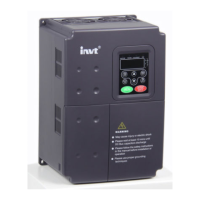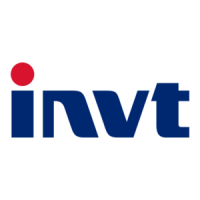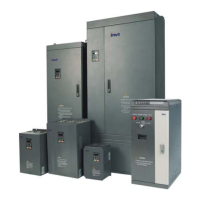What to do if clock chip fault occurs in INVT CHV DC Drives?
- CcarrillobrentSep 23, 2025
Ask for support.

What to do if clock chip fault occurs in INVT CHV DC Drives?
Ask for support.
How to fix inverter overload in INVT DC Drives?
If your INVT DC Drives display 'Inverter overload', it could be due to several reasons. The load might be too heavy, or the Acc/Dec time is too short. Try increasing the Acc/Dec time or selecting an inverter with a bigger capacity. An improper V/F curve could also be the cause; in that case, check and adjust the V/F curve. Lastly, the inverter capacity might be insufficient for the load, so consider selecting a bigger capacity inverter.
Why does over-voltage occur during acceleration in INVT CHV DC Drives?
If your INVT DC Drives experience 'Over-voltage when acceleration', the deceleration time might be too short, causing excessive regenerative energy from the motor. Try increasing the deceleration time or connecting a braking resistor. Additionally, the input voltage may be too high; decrease it to stay within the specified limits.
What to do if there is a motor overload in INVT CHV DC Drives?
If the INVT DC Drives motor is experiencing an overload, consider these potential causes. The motor might be driving a heavy load at low speed for an extended period; if so, select a variable frequency motor. An improper V/F curve could also be the cause; check and adjust the V/F curve. Verify the motor’s overload protection threshold (PB.03) and adjust if necessary. Finally, check the load for any sudden changes.
How to troubleshoot IGBT Ph-U fault in INVT DC Drives?
If the INVT DC Drives show an IGBT Ph-U fault, it could be due to several reasons. The acceleration or deceleration time might be too short, so try increasing it. There might be a malfunction caused by interference, so inspect external equipment and eliminate any interference. Also, ensure that grounding is properly set up. If the issue persists, it could be an IGBT module fault, and you should ask for support.
What to do if external fault occurs in INVT DC Drives?
Inspect external equipment.
What to do if EEPROM fault occurs in INVT CHV?
If the INVT DC Drives display 'EEPROM fault', press STOP/RESET to reset. There may be a read/write fault of control parameters. If the issue persists, ask for support.
What to do if LCD is disconnected in INVT DC Drives?
If the INVT DC Drives display 'LCD disconnected', press STOP/RST to reset, connect the LCD, and then download or upload the parameter. Material might be broken during tension control, so check the material.
How to fix brake unit fault in INVT DC Drives?
If your INVT DC Drives display 'Brake unit fault', it could be due to a braking circuit failure or a damaged brake tube. Inspect the braking unit and replace the braking tube if necessary. Another potential cause is too low resistance of the externally connected braking resistor; in that case, increase the braking resistance.
How to troubleshoot communication fault in INVT DC Drives?
If the INVT DC Drives show a communication fault, it may be due to an improper baud rate setting. In this case, set the proper baud rate. It could also be due to receiving wrong data, so check communication devices and signals. Another potential cause is the communication being interrupted for a long time.
| Output Frequency | 0~400Hz |
|---|---|
| Control Mode | V/F control, Sensorless vector control (SVC), Torque control |
| Output Voltage | 0~Rated Input Voltage |
| Protection Features | Overcurrent, Overvoltage, Undervoltage, Overheating, Short circuit, Phase loss |
| Ambient Temperature | -10°C ~ +40°C |
| Storage Temperature | -20℃~+60℃ |
| Humidity | ≤95% RH, non-condensing |
| Altitude | ≤1000m above sea level |
Highlights critical safety instructions for handling and installing the inverter.
Details the main and control circuit terminal layouts for different models.
Presents a general wiring diagram for inverter connections.
Explains how to wire the main power circuits of the inverter.
Covers wiring precautions and details for control circuit terminals.
Explains the keypad layout, buttons, and indicator lights.
Details procedures for parameter setting, shortcut menu, fault reset, and autotuning.
Provides a flowchart for a quick start-up procedure.
Explains parameters related to starting, stopping, braking, and acceleration/deceleration.
Details how to input and set motor-specific parameters for optimal performance.
Describes settings for vector control, including ASR and torque control parameters.
Covers V/F control settings, including curve selection and torque boost.
Details the configuration and functions of various input terminals.
Details the PID control setup, including preset, feedback sources, and tuning parameters.
Covers various protection settings like phase failure, overload, and over-voltage protection.
Lists fault codes, types, reasons, and solutions for common inverter issues.
Provides solutions for common operational issues like no display or motor not moving.












